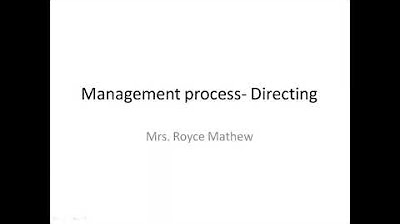PRESENTASI KELOMPOK 3 ACTUATING, DEDY SAPUTRA DAN RAKA BRAMA SIDDIQ
Summary
TLDRThis presentation by Group 3 explores key management functions, focusing on directing and motivating employees within an organization. The importance of motivation in achieving organizational goals is emphasized, along with various motivation theories such as Maslow's Hierarchy of Needs, McGregor’s Theory X and Y, and Herzberg’s Two-Factor Theory. The presentation highlights how motivation influences employee behavior, performance, and overall organizational success. It also discusses the application of these theories in real-world settings, stressing the need for leaders to adapt motivational strategies to different employee needs to ensure productivity and goal achievement.
Takeaways
- 😀 Motivation is essential in directing and guiding organizational members to achieve both company and personal goals.
- 😀 A leader's role is to motivate their team, ensuring they work confidently and effectively towards achieving organizational objectives.
- 😀 Motivation plays a crucial role in overcoming resistance, fostering action, and encouraging the pursuit of goals.
- 😀 Maslow's hierarchy of needs helps in understanding how human motivation progresses from basic physiological needs to self-actualization.
- 😀 McGregor's Theory X and Theory Y presents two views: Theory X sees people as lazy and requiring supervision, while Theory Y views work as a natural responsibility and opportunity.
- 😀 The Two-Factor Theory by Herzberg identifies motivators (e.g., achievement, recognition) and hygiene factors (e.g., salary, working conditions) that influence job satisfaction and performance.
- 😀 Contemporary motivation theories, like Clayton Alderfer's ERG theory, simplify Maslow's hierarchy into existence, relatedness, and growth needs.
- 😀 The Goal Setting Theory emphasizes that clear, challenging goals with expected rewards motivate individuals to perform well.
- 😀 The Equity Theory addresses how individuals compare their efforts and rewards to others, highlighting the impact of perceived fairness on motivation.
- 😀 Reinforcement Theory states that past behaviors influence future outcomes, with positive actions leading to promotions and negative behaviors leading to layoffs.
- 😀 Effective motivation requires understanding the needs of employees at different levels, with new employees focusing on basic needs and professionals motivated by achievement and fairness.
Q & A
What is the importance of motivation in the management process?
-Motivation plays a crucial role in management as it helps move members of the organization according to the plan. Without motivation, planning and organizing efforts would be meaningless. It is necessary for guiding employees to achieve both personal and company goals.
How does motivation influence organizational effectiveness?
-Motivation influences organizational effectiveness by encouraging employees to work with enthusiasm, commitment, and persistence, which leads to higher productivity and better achievement of company goals.
What are the two key functions of motivation in management?
-The two key functions of motivation in management are to encourage actions and to direct these actions towards achieving desired goals. Motivation also helps overcome reluctance and transforms it into enthusiasm for work.
How do different levels of motivation affect employee performance?
-Higher levels of motivation are directly proportional to the speed and quality of work. Motivated employees tend to perform their tasks faster and with greater attention to detail, thus improving overall work output.
What is Maslow's hierarchy of needs, and how does it relate to motivation?
-Maslow's hierarchy of needs is a theory that categorizes human needs into five levels: physiological, safety, affection, appreciation, and self-actualization. Leaders can motivate employees by ensuring that their needs are met at each level, which drives them to perform better.
How does McGregor's Theory X and Theory Y affect employee motivation?
-McGregor's Theory X and Theory Y present two different views on employee motivation. Theory X assumes employees are inherently lazy and need supervision, while Theory Y believes that employees are responsible and motivated to work. Leaders can use these theories to tailor their approach to motivation.
What is Herzberg's two-factor theory of motivation?
-Herzberg's two-factor theory identifies motivators (such as achievement and recognition) and hygiene factors (such as salary and working conditions). Motivators lead to job satisfaction and higher performance, while hygiene factors prevent dissatisfaction but do not necessarily improve motivation.
What are the implications of motivation theories on organizational behavior?
-Motivation theories like reinforcement theory, expectancy theory, and the theory of justice can significantly affect organizational behavior. These theories help understand how employees' actions and motivations are influenced by rewards, fairness, and past experiences, which ultimately shape their performance.
What is the importance of applying the correct motivation theory in a company?
-Applying the correct motivation theory is essential for enhancing employee engagement and productivity. Different employees, such as new hires or experienced professionals, may be motivated by different factors. Tailoring motivation strategies to their needs ensures better alignment with company goals.
How do reinforcement and expectancy theories influence employee motivation?
-Reinforcement theory suggests that employees are motivated by the consequences of their behavior, with positive behaviors leading to rewards and negative behaviors resulting in penalties. Expectancy theory, on the other hand, states that employees are motivated when they believe their efforts will lead to desirable outcomes, such as rewards or promotions.
Outlines

This section is available to paid users only. Please upgrade to access this part.
Upgrade NowMindmap

This section is available to paid users only. Please upgrade to access this part.
Upgrade NowKeywords

This section is available to paid users only. Please upgrade to access this part.
Upgrade NowHighlights

This section is available to paid users only. Please upgrade to access this part.
Upgrade NowTranscripts

This section is available to paid users only. Please upgrade to access this part.
Upgrade Now5.0 / 5 (0 votes)





